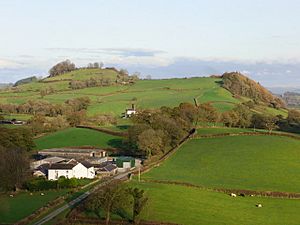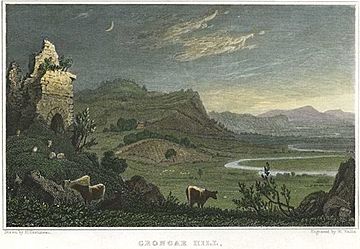Grongar Hill facts for kids
Grongar Hill is a famous hill in Carmarthenshire, Wales. It became well-known because of a poem written about it by John Dyer. The poem was published in 1726. It describes the beauty of the landscape and how it makes a person feel. This made it an early example of a new style of poetry called Romanticism.
Contents
Where is Grongar Hill Located?
Grongar Hill is in the area of Llangathen, close to the River Tywi. It rises sharply from the ground. The hill's name comes from an Iron Age fort on its top. In Welsh, "gron gaer" means "circular fort."
At the bottom of the hill is Aberglasney, a restored old house. This was once the home of John Dyer's family. He grew up there starting in 1710. This area was important during the Middle Ages when Wales was independent. From the top of the 150-meter hill, you can see the ruins of several castles. These include the grand Dinefwr Castle and Dryslwyn Castle.
What is John Dyer's Poem About?
John Dyer's poem about Grongar Hill first appeared in 1726. It was part of a collection of poems. The first version of the poem used a style called "pindarics." It had many old-fashioned poetic words. For example, it mentioned "mossy Cells" and "shado’wy Side."
Later that same year, Dyer rewrote the poem. This new version is the one people remember today. It was written in shorter lines that rhymed. A writer named Geoffrey Tillotson said it was like poems by John Milton and Andrew Marvell. Dyer learned from Milton how to keep the poem flowing smoothly.
Dyer's poem is shorter than many others of its kind, with only 158 lines. It is also more general. While it names Grongar Hill and the River Tywi, it does not name the old castles nearby. Instead, the castles are used to create a feeling. They are described as old and ruined places:
'Tis now the Raven's bleak Abode;
'Tis now th'Apartment of the Toad;
And there the Fox securely feeds;
And there the pois'nous Adder breeds,
Conceal'd in Ruins, Moss and Weeds:
From seeing these ruins, the poet learns to be happy with simple things. He finds joy in being on the hill. The poem shares a personal feeling of happiness from nature. It is not meant to teach a public lesson.
How Painting Influenced the Poem
John Dyer had also trained as a painter. This skill influenced his poem. At the start of the poem, he talks to a "silent nymph, with curious eye." He asks her to help his "sister Muse" (poetry). This shows how poetry and painting work together:
Grongar Hill invites my Song,
Draw the Landskip bright and strong;
The word "Landskip" was an art term back then. Other art words like "vistoes" (views) and "prospect" (a wide view) also appear. The poem focuses a lot on what you see. For example, it describes how the view changes as you climb the hill. It also compares different parts of the view to "pearls upon an Ethiop’s arm."
Even though the poem does not describe every tiny detail, what Dyer sees from the top is real. Critics believe that painters like Claude Lorrain, Nicolas Poussin, and Salvator Rosa influenced Dyer. Rosa was also a poet and a painter, like Dyer. The soft light in Dyer's poem is like Claude's paintings. The view from the hill, with the river below and distant towers, is similar to Rosa's "Mountain Landscape."
A Personal Touch in Poetry
Dyer's poem was different because it had a very personal tone. It showed how the landscape made the poet feel. Samuel Johnson, a famous writer, said that once you read it, you would want to read it again. Another writer said that Dyer's gentle lessons came naturally from how nature affected him. He was not just trying to teach a lesson.
This personal style helped lead to the Romanticism movement in poetry. William Wordsworth, a famous Romantic poet, wrote a poem about Dyer. Wordsworth praised Dyer for creating a "living landscape." He said people would remember it "Long as the thrush shall pipe on Grongar Hill." This refers to the end of Dyer's poem. Wordsworth believed Dyer's poem showed "emotion recollected in tranquillity." This means thinking about a feeling later, when you are calm.
How Artists and Writers Saw the Poem
John Dyer also wrote a letter to his painting teacher, Jonathan Richardson. In it, he said he could "but in verse can paint." After Dyer died, this letter was included with his poems. It reminded people that he practiced both poetry and painting.
Later, some art experts questioned Dyer's poem. William Gilpin, who wrote about "Picturesque Beauty" (a style of art), thought Dyer's poem was not good enough. He said Dyer's descriptions of far-away things were "all in confusion." Gilpin also thought it was wrong to describe the ivy on Dinefwr Castle in too much detail.
However, not everyone agreed with Gilpin. Edward Dayes, an artist, praised Dyer's description of trees. He said it showed how important it is to have different shapes and colors in a painting.
Bishop John Jebb defended the poem. He said that a poet should not be limited by painting rules. He felt that the details in Dyer's poem helped readers connect with the story. Gilpin's own nephew, William Sawrey Gilpin, also agreed with the bishop. He asked, "Can the mind be pleased, nay delighted, without being interested?"
The discussion about the poem's painting-like qualities continued for a long time. Some critics thought it was like a painting by Claude Lorrain. Others disagreed, saying the poem's descriptions were random. They felt the poet kept stopping to add a moral lesson. However, it is a poet's job to comment. Dyer did separate his descriptions from his moral lessons.
Tributes to Grongar Hill
The poem "Grongar Hill" has been honored in different ways. A young poet named William Combe mentioned Dyer's poem in his own work. Later, Combe even made fun of William Gilpin's ideas about art. Another young poet, Samuel Taylor Coleridge, parodied the poem's opening lines in 1791.
In the 1800s, the poem was translated into Welsh twice. The first translation was Twyn Grongar in 1832. The second was Bryn y Grongaer by William Davies. The hill itself was painted by Henry Gastineau early in the century. It also appeared as a woodcut in a book called Wales Illustrated in 1830.
The poem was often included in poetry collections. However, it was not published as a single book until 1941. There were also some special small editions. These included one with woodcuts by Pamela Hughes in 1963.
The artist John Piper loved the poem. He called it "one of the best topographical poems in existence because it is so visual." He painted the hill in 1942. Later, he made three lithographs for a special edition of the poem in 1982.
The Welsh composer Alun Hoddinott also set Dyer's words to music. He knew the area well from his youth. In 1998, he used four parts of the poem for a piece called "Grongar Hill." He also set other parts to music in 2006, calling it "Towy Landscape."




